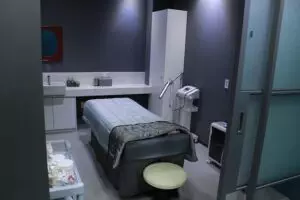Revolutionize Your Skin: Unlocking RF Skin Resurfacing’s Advanced Benefits
RF Skin Resurfacing is a non-invasive dermatology treatment using radiofrequency energy to stimulate…….

RF Skin Resurfacing is a non-invasive dermatology treatment using radiofrequency energy to stimulate collagen production for skin rejuvenation. It offers minimal downtime, improves texture, reduces fine lines and scars, and evens out skin tone. This customizable treatment targets specific areas, making it suitable for various skin concerns. The procedure involves heating the dermis to boost collagen, resulting in a smoother, more youthful complexion. Bipolar and unipolar RF devices cater to different depths of skin penetration. Ideal candidates are those with moderate to severe aging signs, commitment to post-treatment care, and healthy skin. Potential risks include temporary redness and swelling, but patient testimonials show positive outcomes over time.
“Unveil youthful skin with advanced RF skin resurfacing—a revolutionary technology transforming dermatological treatments. This comprehensive guide delves into the intricacies of RF skin resurfacing, exploring its benefits, underlying science, and various applications.
From understanding the technology to navigating candidate selection and procedure steps, we demystify this game-changing procedure. Discover how RF energy reshapes skin, reduces scars, and enhances overall texture. Learn about different device types, potential risks, and real patient experiences. Optimize your skincare journey with this insightful exploration of RF skin resurfacing.”
Understanding RF Skin Resurfacing: Unveiling the Technology

RF Skin Resurfacing is a revolutionary technology that has taken the dermatology world by storm. This advanced technique utilizes radiofrequency (RF) energy to deeply penetrate the skin, stimulating collagen production and triggering cellular renewal. Unlike traditional skin resurfacing methods, RF offers a non-invasive approach with minimal downtime, making it an increasingly popular choice for those seeking youthful, radiant skin.
The technology behind RF Skin Resurfacing involves delivering precise RF energy to the deeper layers of the epidermis and dermis. This controlled heat promotes collagen and elastin fiber stimulation, improving skin texture, reducing fine lines, and minimizing the appearance of scars or uneven tones. With its ability to target specific areas and offer customizable treatments, RF Skin Resurfacing provides a safe and effective solution for various skin concerns, ensuring patients achieve remarkable results with minimal discomfort.
Benefits of Advanced Skin Resurfacing Techniques

Advanced skin resurfacing techniques, such as RF (Radio Frequency) Skin Resurfacing, offer a multitude of benefits for those seeking to enhance their skin’s appearance and texture. RF Skin Resurfacing, in particular, has gained popularity due to its non-invasive nature, which minimizes downtime and recovery compared to traditional surgical methods. This innovative technology stimulates collagen production by heating the deep layers of the skin, leading to improved skin elasticity and a reduced appearance of fine lines, wrinkles, and scars.
Beyond collagen stimulation, advanced resurfacing techniques can also improve skin tone and texture, providing a smoother, more even complexion. Many people experience long-lasting results, boosting their confidence in their skin’s radiance and overall health. Moreover, these procedures are often tailored to individual needs, ensuring personalized treatment plans for optimal outcomes.
The Science Behind RF (Radio Frequency) Energy in Dermatology

Radio Frequency (RF) energy has emerged as a powerful tool in dermatology, offering advanced skin resurfacing solutions. This technology harnesses the power of electromagnetic waves to stimulate collagen production and improve skin texture. By sending precise energy pulses into the deeper layers of the dermis, RF Skin Resurfacing prompts the body’s natural healing process, leading to a rejuvenated and smoother complexion.
The procedure is non-invasive, making it an attractive option for those seeking cosmetic improvements without extensive downtime. RF energy works by heating the targeted area, causing controlled damage that triggers collagen remodeling. This process helps to reduce fine lines, wrinkles, and scars, providing patients with a more youthful and even skin tone. With its ability to target specific concerns, RF Skin Resurfacing offers a customized approach to achieving healthy, radiant skin.
Types of RF Skin Resurfacing Devices and Their Applications

Radiofrequency (RF) skin resurfacing devices have emerged as innovative tools in the dermatology field, offering a non-invasive approach to rejuvenate and transform the skin’s surface. These advanced technologies utilize targeted radio waves to stimulate collagen production and improve skin texture. One popular type is the bipolar RF device, which delivers precise energy to specific depths, effectively tightening loose skin and reducing fine lines and wrinkles. This method is particularly effective for facial resurfacing, providing significant improvements in skin elasticity and a more youthful appearance.
Another variant, unipolar RF devices, provides deeper penetration, making them ideal for treating larger areas and addressing more severe skin concerns. They are commonly used to improve acne scars, stretch marks, and overall skin tone. The ability to customize energy settings allows dermatologists to tailor treatments to individual patient needs, ensuring optimal results with minimal side effects. RF skin resurfacing offers a safe and effective alternative to surgical procedures, appealing to those seeking natural-looking enhancements.
Candidate Selection: Who is a Good Fit for This Procedure?

Skin resurfacing with RF (Radio Frequency) technology has gained popularity as a non-invasive procedure for achieving smoother, more youthful-looking skin. The ideal candidates for this treatment are individuals who have moderate to severe signs of skin aging, such as fine lines, wrinkles, and uneven skin texture. It is suitable for those with realistic expectations and a commitment to maintaining consistent skincare routines post-procedure.
A good fit for RF Skin Resurfacing often includes people with healthy skin, free from active acne or skin conditions that might interfere with healing. Individuals with a history of successful responses to other anti-aging treatments may also benefit from this procedure. It’s crucial to consider one’s lifestyle and environmental factors; those who spend significant time outdoors or in harsh climates might require additional protection measures post-treatment.
Procedure Steps: A Step-by-Step Guide to RF Resurfacing

RF (Radio Frequency) skin resurfacing is a non-invasive procedure that uses targeted heat to stimulate collagen production and rejuvenate the skin’s surface. Here’s a step-by-step guide to help you understand this advanced skin rejuvenation technique.
1. Preparation: Before starting, a healthcare professional will clean your skin and apply a topical anesthetic to minimize discomfort. You may also be given protective eye gear to wear during the procedure. The device used for RF resurfacing is then selected based on your specific skin concerns and desired outcomes.
2. Device Application: The specialist will gently place the RF device on your skin, ensuring it makes good contact with all areas to be treated. The device emits radio waves that penetrate deep into the dermis layer of the skin, heating collagen fibers without damaging the surface. As the treatment progresses, you may feel a warm sensation—a normal part of the process.
3. Heat Application & Collagen Stimulation: The RF energy stimulates fibroblasts to produce new collagen and elastin, enhancing skin texture and elasticity. This controlled heat also helps to tighten the skin by contracting existing collagen fibers.
4. Post-Treatment Care: After the procedure, your skin may appear slightly flushed and mild swelling or redness is common. A healthcare professional will provide aftercare instructions, which may include the use of specific skincare products and protection from sun exposure. It’s important to follow these guidelines for optimal healing.
Post-Treatment Care and Recovery: What to Expect

After undergoing advanced skin resurfacing treatments like RF Skin Resurfacing, proper post-care is essential for optimal healing and results. Patients can expect a period of redness, swelling, and mild discomfort, which typically peaks within 24 to 48 hours after the procedure. It’s crucial to follow your dermatologist’s instructions regarding cleaning, moisturizing, and protecting the treated area from sun exposure.
During recovery, staying hydrated and maintaining a gentle skincare routine is vital. Avoid strenuous activities and direct sunlight for the first week or as recommended by your specialist. As the skin heals, it may feel tighter and appear flakier than usual, but this is normal part of the process. This period requires patience, and consistent adherence to aftercare guidelines will facilitate faster recovery and lead to smoother, more youthful-looking skin.
Potential Risks, Complications, and Patient Testimonials

Skin resurfacing procedures, while promising youthful-looking skin, are not without potential risks and complications. One such advanced technique, RF Skin Resurfacing (Radiofrequency skin tightening), involves using precise radiofrequency energy to stimulate collagen production and improve skin texture. However, as with any medical procedure, there are considerations. Some patients may experience temporary redness, swelling, or discomfort after the treatment, and in rare cases, more severe reactions like blistering or infection can occur. It’s crucial for patients to choose a reputable clinic and follow their doctor’s post-procedure care instructions to mitigate these risks.
Patient testimonials offer valuable insights into the real-world experiences of RF Skin Resurfacing. Many report noticeable improvements in skin tone and texture, with results that persist over time. However, individual outcomes vary, and some patients share stories of initial redness or slight scarring that faded within a few weeks. These accounts underscore the importance of realistic expectations and highlight the fact that open communication between patient and practitioner is key to achieving desired results safely and effectively.







